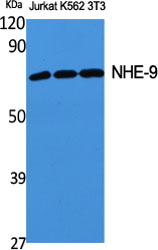NHE-9 Polyclonal Antibody
- Catalog No.:YT3120
- Applications:WB;ELISA
- Reactivity:Human;Mouse
- Target:
- NHE-9
- Gene Name:
- SLC9A9
- Protein Name:
- Sodium/hydrogen exchanger 9
- Human Gene Id:
- 285195
- Human Swiss Prot No:
- Q8IVB4
- Mouse Gene Id:
- 331004
- Mouse Swiss Prot No:
- Q8BZ00
- Immunogen:
- The antiserum was produced against synthesized peptide derived from human SLC9A9. AA range:171-220
- Specificity:
- NHE-9 Polyclonal Antibody detects endogenous levels of NHE-9 protein.
- Formulation:
- Liquid in PBS containing 50% glycerol, 0.5% BSA and 0.02% sodium azide.
- Source:
- Polyclonal, Rabbit,IgG
- Dilution:
- WB 1:500 - 1:2000. ELISA: 1:40000. Not yet tested in other applications.
- Purification:
- The antibody was affinity-purified from rabbit antiserum by affinity-chromatography using epitope-specific immunogen.
- Concentration:
- 1 mg/ml
- Storage Stability:
- -15°C to -25°C/1 year(Do not lower than -25°C)
- Other Name:
- SLC9A9;NHE9;Nbla00118;Sodium/hydrogen exchanger 9;Na(+)/H(+) exchanger 9;NHE-9;Solute carrier family 9 member 9
- Observed Band(KD):
- 65kD
- Background:
- This gene encodes a sodium/proton exchanger that is a member of the solute carrier 9 protein family. The encoded protein localizes the to the late recycling endosomes and may play an important role in maintaining cation homeostasis. Mutations in this gene are associated with autism susceptibility 16 and attention-deficit/hyperactivity disorder. [provided by RefSeq, Mar 2012],
- Function:
- disease:A chromosomal aberration involving SLC9A9 may be a cause of early-onset behavioral/developmental disorder with features of attention deficit-hyperactivity disorder and intellectual disability (ADHD) [MIM:143465]. Inversion inv(3)(p14:q21). The inversion disrupts SLC9A9 and DOCK3.,function:May act in electroneutral exchange of protons for Na(+) across membranes. Involved in the effusion of Golgi luminal H(+) in exchange for cytosolic cations. Involved in organelle ion homeostasis by contributing to the maintainance of the unique acidic pH values of the Golgi and post-Golgi compartments in the cell.,similarity:Belongs to the monovalent cation:proton antiporter 1 (CPA1) transporter (TC 2.A.36) family.,tissue specificity:Ubiquitously expressed in all tissues tested. Expressed at highest levels in heart and skeletal muscle, followed by placenta, kidney, and liver. Expressed in the bra
- Subcellular Location:
- Late endosome membrane ; Multi-pass membrane protein .
- Expression:
- Ubiquitously expressed in all tissues tested. Expressed at highest levels in heart and skeletal muscle, followed by placenta, kidney, and liver. Expressed in the brain, in the medulla and spinal cord.
- June 19-2018
- WESTERN IMMUNOBLOTTING PROTOCOL
- June 19-2018
- IMMUNOHISTOCHEMISTRY-PARAFFIN PROTOCOL
- June 19-2018
- IMMUNOFLUORESCENCE PROTOCOL
- September 08-2020
- FLOW-CYTOMEYRT-PROTOCOL
- May 20-2022
- Cell-Based ELISA│解您多样本WB检测之困扰
- July 13-2018
- CELL-BASED-ELISA-PROTOCOL-FOR-ACETYL-PROTEIN
- July 13-2018
- CELL-BASED-ELISA-PROTOCOL-FOR-PHOSPHO-PROTEIN
- July 13-2018
- Antibody-FAQs
- Products Images

- Western Blot analysis of various cells using NHE-9 Polyclonal Antibody
.jpg)
- Western Blot analysis of RAW264.7 cells using NHE-9 Polyclonal Antibody

- Western blot analysis of lysates from A549 cells, using SLC9A9 Antibody. The lane on the right is blocked with the synthesized peptide.



